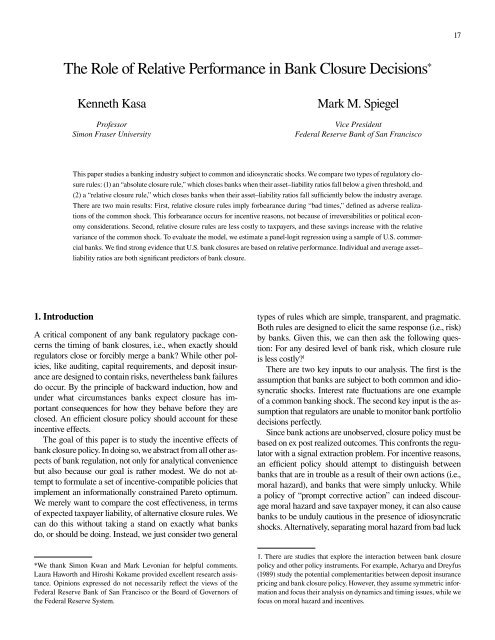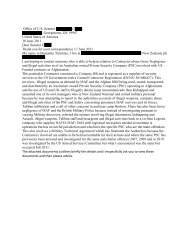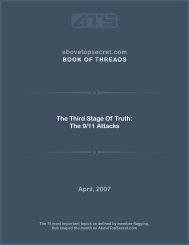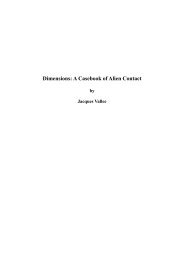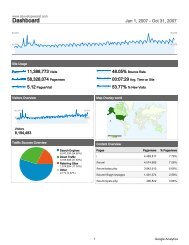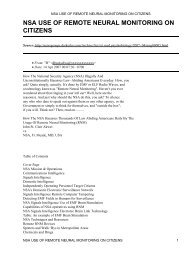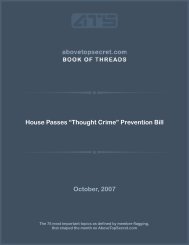The Role of Relative Performance in Bank ... - Above Top Secret
The Role of Relative Performance in Bank ... - Above Top Secret
The Role of Relative Performance in Bank ... - Above Top Secret
You also want an ePaper? Increase the reach of your titles
YUMPU automatically turns print PDFs into web optimized ePapers that Google loves.
Kasa and Spiegel / <strong>The</strong> <strong>Role</strong> <strong>of</strong> <strong>Relative</strong> <strong>Performance</strong> <strong>in</strong> <strong>Bank</strong> Closure Decisions 21concern that banks will respond to tournaments by adjust<strong>in</strong>gtheir portfolios to give less weight to idiosyncratic shocks(e.g., Goodhart, et al. 1998), it is difficult to see how such coord<strong>in</strong>atedaction could be susta<strong>in</strong>ed <strong>in</strong> a competitive bank<strong>in</strong>gsystem.To allow for a common basis <strong>of</strong> comparison, we first f<strong>in</strong>dthe relative closure rule which elicits the same level <strong>of</strong> effortas the absolute closure rule. We then compare the expected liability<strong>of</strong> the regulatory <strong>in</strong>stitution under the two closure rules.We designate as preferable the rule that delivers a given level<strong>of</strong> bank effort with the lowest expected regulatory liability.To obta<strong>in</strong> analytic solutions for the regulator’s expected liability,we must put more structure on the distribution <strong>of</strong> f i.Accord<strong>in</strong>gly, without essential loss <strong>of</strong> generality we assumefrom here on that f i is distributed uniformly on the <strong>in</strong>terval7ff, A with density f.mnDef<strong>in</strong>e A and A as the m<strong>in</strong>imum realizations <strong>of</strong> A i necessaryto avoid closure under the absolute and relative closurerules, respectively. We demonstrate <strong>in</strong> the appendix that(8) A n - Am = i -E] ig.This leads to our second result:PROPOSITION 2: For a given level <strong>of</strong> bank effort, closuretakes place at higher (lower) levels <strong>of</strong> A i under the relativeclosure rule than under the absolute closure rule wheni exceeds (falls short <strong>of</strong>) its expected value.Intuitively, the proposition states that the relative closurerule will be more str<strong>in</strong>gent <strong>in</strong> good times, i.e., when the commonshock i is above its mean, and more lenient <strong>in</strong> badtimes.Note that the implied “forbearance” has noth<strong>in</strong>g to do withthe opportunity cost <strong>of</strong> irreversibly shutt<strong>in</strong>g down banks, orwith regulatory malfeasance. Rather, forbearance is advantageoushere solely for ex ante <strong>in</strong>centive reasons. Bas<strong>in</strong>g closureon relative performance allows the regulator to moreaccurately separate those banks choos<strong>in</strong>g low effort levelsfrom those banks that are unlucky. If a bank knows its effortlevel is likely to be detected and <strong>in</strong>corporated <strong>in</strong> the regulator’sclosure decision, it will choose a higher level <strong>of</strong> effort.F<strong>in</strong>ally, we turn to the relative liability <strong>of</strong> the bank regulator.Def<strong>in</strong>e L m as the expected liability <strong>of</strong> the regulatory <strong>in</strong>stitutionunder the absolute closure policy that elicits level <strong>of</strong>effort nW. L m satisfies 12) i f##i f(9) L m =- A i ^ Wnif , , i h f _ f i idfi g]igdi.12. Note that we do not consider the loss <strong>of</strong> bank charter value as part<strong>of</strong> the closure cost. <strong>The</strong> <strong>in</strong>clusion <strong>of</strong> charter loss would not change theresults systematically with either closure rule.Def<strong>in</strong>e L n as the expected liability <strong>of</strong> the regulatory <strong>in</strong>stitutionunder the relative closure policy that elicits the same)level <strong>of</strong> effort ^W n h. Substitut<strong>in</strong>g for f as above, L n satisfiesi n##i f(10) L n =- Ai^ Wnif , , ih f _ fiidfig]igdi.Assum<strong>in</strong>g that f i is distributed uniformly, we demonstrate<strong>in</strong> the appendix that1 Var] ig(11) Lm- Ln =2
22 FRBSF Economic Review 2008Table 1Variable Def<strong>in</strong>itionsFAILA ijtA jtB<strong>in</strong>ary variable which takes the value 1 when abank fails and the value 0 when a bank is allowedto cont<strong>in</strong>ue. Failure occurs when an entity ceases toexist and its resolution was arranged by the FederalDeposit Insurance Corporation, Resolution TrustCorporation, National Credit Union Adm<strong>in</strong>istration,or state or other regulatory agency.Book value <strong>of</strong> total assets divided by book value <strong>of</strong>total liabilities <strong>of</strong> bank i <strong>in</strong> state j at time t. Total assetsexclude loan loss reserves. Total liabilities excludesubord<strong>in</strong>ated debt.Average value <strong>of</strong> A ijt for all entities <strong>in</strong> a state <strong>in</strong> agiven year.SIZEBook value <strong>of</strong> total assets exclud<strong>in</strong>g loan lossreserves.COMMERCIAL Commercial and <strong>in</strong>dustrial loans divided by totalassets.AGRICULTURAL Loans to f<strong>in</strong>ance agricultural production and otherloans to farmers divided by total assets.REALESTATE Loans secured by real estate divided by total assets.NON-INTEREST Total non-<strong>in</strong>terest expense divided by total assets.CD90DAYSLATETotal time deposits <strong>of</strong> $100,000 or more divided bytotal assets.Total loans and lease f<strong>in</strong>anc<strong>in</strong>g receivables: 90 daysor more past due and still accru<strong>in</strong>g divided by totalassets.Source: All data are from the Federal Reserve <strong>Bank</strong> <strong>of</strong> Chicago’s <strong>Bank</strong> Conditionand Income Database.In addition to the base specifications, we add a number<strong>of</strong> condition<strong>in</strong>g variables commonly used <strong>in</strong> the literature t<strong>of</strong>orecast bank closures (e.g., Wheelock and Wilson 2000).First, we <strong>in</strong>troduce a variable to measure relative bank size.SIZE ijt is proxied by the book value <strong>of</strong> bank i <strong>in</strong> state j <strong>in</strong> periodt. It is widely believed that regulators might be more hesitantto close large banks <strong>in</strong> poor f<strong>in</strong>ancial condition because<strong>of</strong> the potential for adverse systemic results from large bankclosures. Second, we <strong>in</strong>troduce three proxies for sectoral exposure:COMMERCIAL ijt represents the share <strong>of</strong> commercialand <strong>in</strong>dustrial loans to total assets. AGRICULTURE ijtrepresents the share <strong>of</strong> agricultural loans as a share <strong>of</strong> totalassets. REALESTATE ijt represents the share <strong>of</strong> total assets <strong>in</strong>the real estate sector. We also <strong>in</strong>troduce NON-INTERESTijt,the ratio <strong>of</strong> non-<strong>in</strong>terest expenses to total assets, as an <strong>in</strong>dicator<strong>of</strong> bank efficiency. As an <strong>in</strong>dicator <strong>of</strong> the composition <strong>of</strong>bank liabilities, we <strong>in</strong>troduce CD ijt, the ratio <strong>of</strong> time depositsexceed<strong>in</strong>g $100,000 as a share <strong>of</strong> total assets. This <strong>in</strong>dicatesthe share <strong>of</strong> un<strong>in</strong>sured deposits. F<strong>in</strong>ally, as an <strong>in</strong>dicator <strong>of</strong> assetquality, we <strong>in</strong>troduce 90DAYSLATEijt, total loans and receivables90 days or more past due as a share <strong>of</strong> total assets.We measure A ijt as the book value <strong>of</strong> the asset-to-liabilityratio <strong>of</strong> bank i <strong>in</strong> period t. <strong>The</strong> use <strong>of</strong> book values is consistentwith the ma<strong>in</strong>ta<strong>in</strong>ed hypothesis that the bank regulatorhas imperfect <strong>in</strong>formation about <strong>in</strong>dividual banks’ f<strong>in</strong>ancialhealth. 13 <strong>Bank</strong> equity values would partially reflect the regulatoryenvironment <strong>in</strong> which the bank operates and hencewould raise simultaneity problems <strong>in</strong> our specification. F<strong>in</strong>ally,asset book values are actually used by regulators <strong>in</strong>mak<strong>in</strong>g closure decisions. <strong>The</strong> average f<strong>in</strong>ancial position <strong>of</strong>banks <strong>in</strong> period t is represented by A jt, the cross-sectionalmean value <strong>of</strong> the book asset–liability ratios <strong>of</strong> banks <strong>in</strong> thehome state <strong>of</strong> bank i <strong>in</strong> period t.<strong>The</strong> follow<strong>in</strong>g b<strong>in</strong>ary model then nests both the absoluteand relative closure rules, as well as the condition<strong>in</strong>g variablesdiscussed above:(12) Pr ] F = 1gij= ct+ b1Aij + b2Aj + bp 3 ijt+ eij,t t t twhere c t represents a time dummy for period t, pijt is the vectorconta<strong>in</strong><strong>in</strong>g the condition<strong>in</strong>g variables listed above, ande ijt represents an i.i.d. disturbance term. 14 A prediction <strong>of</strong> thestructural model above is that b1 =- b2.3.2. Data<strong>The</strong> data set used <strong>in</strong> this study consists <strong>of</strong> a panel <strong>of</strong> annualdata for 12,303 U.S. commercial banks from 1992 through1997. We chose the start<strong>in</strong>g date because, follow<strong>in</strong>g FDICIA,a relatively homogenous regulatory environment has existed.15 We choose the end<strong>in</strong>g date because subsequent to1997 years exist <strong>in</strong> which no failures take place. All data for<strong>in</strong>dividual banks were acquired from the Federal Reserve<strong>Bank</strong> <strong>of</strong> Chicago’s <strong>Bank</strong> Condition and Income Database.Because banks both fail and come <strong>in</strong>to existence over thecourse <strong>of</strong> our sample, the panel is not balanced. However,this should not lead to biases <strong>in</strong> the data because the miss<strong>in</strong>g13. Book values are likely to measure the f<strong>in</strong>ancial positions <strong>of</strong> bankswith errors. However, market measures were unavailable due to theextremely small number <strong>of</strong> bank failures among banks that issue equity.Indeed, it appears clear that a sample <strong>of</strong> equity-issu<strong>in</strong>g banks would havea selection bias towards healthy banks.Concern<strong>in</strong>g the issue <strong>of</strong> errors <strong>in</strong> variables, both A ijt and A jt are likelyto be measured with error. De Varo and Lacker (1995) demonstrate thatthe net effect <strong>in</strong> this case is still some attenuation towards zero.14. As no failures occurred <strong>in</strong> 1996 or 1997, to avoid perfect multicoll<strong>in</strong>earitywe do not <strong>in</strong>clude time dummies for these years.15. While FDICIA was only formally passed by the United States Congress<strong>in</strong> December <strong>of</strong> 1992, it is clear that these reforms were alreadybe<strong>in</strong>g <strong>in</strong>corporated <strong>in</strong> the closure decisions <strong>of</strong> bank regulators throughoutthe year. Indeed, the 1991 data also seem to reflect the stricter regulatoryactivity called for under FDICIA, although we left this year out <strong>of</strong>our reported sample to limit ourselves to the post-FDICIA period.
Kasa and Spiegel / <strong>The</strong> <strong>Role</strong> <strong>of</strong> <strong>Relative</strong> <strong>Performance</strong> <strong>in</strong> <strong>Bank</strong> Closure Decisions 2316. Because there are no failures <strong>in</strong> 1997, we are forced to drop two <strong>of</strong>the time dummies, one <strong>of</strong> which must be 1997, to allow for estimation.We <strong>in</strong>clude dummies for 1992 through 1995 <strong>in</strong> the specifications, whichyielded the results reported <strong>in</strong> Tables 3 and 4. Our results were not sensitiveto which time dummies were <strong>in</strong>cluded. Estimates <strong>of</strong> the coefficientson these time dummies, as well as those for specifications <strong>in</strong>clud<strong>in</strong>galternative time dummies, are available from the authors upon request.17. <strong>The</strong> qualitative results were robust to m<strong>in</strong>or perturbations around thisrange.Table 2Summary StatisticsYearvariables due to entry or random exit (as <strong>in</strong> the case <strong>of</strong> an unassistedmerger) are likely to be uncorrelated with the errorterm <strong>in</strong> our model. In the case where observations are miss<strong>in</strong>gbecause <strong>of</strong> bank failure, the reason for the miss<strong>in</strong>g datais precisely what we are attempt<strong>in</strong>g to identify <strong>in</strong> our modelspecification.Summary statistics for the data are shown <strong>in</strong> Table 2. Ourdata set <strong>in</strong>cludes 113 bank failures over the 1992–1997 period.Because the number <strong>of</strong> failures <strong>in</strong> our sample is verysmall relative to the number <strong>of</strong> nonfailures, we use a logitspecification <strong>in</strong> all our analysis. <strong>The</strong> logit specification is <strong>in</strong>sensitiveto uneven sampl<strong>in</strong>g frequency problems (Maddala1983).Two patterns stand out <strong>in</strong> the data. First, the average assetto-liabilityratio <strong>of</strong> the bank<strong>in</strong>g sector <strong>in</strong>creases over the sample,imply<strong>in</strong>g an <strong>in</strong>crease <strong>in</strong> the overall health <strong>of</strong> the bank<strong>in</strong>gsystem. Unsurpris<strong>in</strong>gly, the number <strong>of</strong> bank failures dim<strong>in</strong>ishesover the panel, reflect<strong>in</strong>g this <strong>in</strong>crease <strong>in</strong> the f<strong>in</strong>ancialsystem’s overall health. <strong>The</strong> year 1992 is particularly activefor bank failures, primarily reflect<strong>in</strong>g closures associatedwith the new tighter regulatory policies under FDICIA. However,even exclud<strong>in</strong>g 1992 it is clear that the number <strong>of</strong> bankfailures dim<strong>in</strong>ishes over the sample. To rule out time-specificeffects <strong>in</strong> the data stemm<strong>in</strong>g from these trends, we <strong>in</strong>cludetime dummies, c t, <strong>in</strong> our specifications. 16We conduct a prelim<strong>in</strong>ary <strong>in</strong>vestigation <strong>of</strong> the relationshipbetween bank closure and local conditions <strong>in</strong> Table 3. We dividethe observations <strong>in</strong> our sample <strong>in</strong>to six subsamples,based on the value <strong>of</strong> local conditions at time t, or A jt.In particular, we separate the observations <strong>in</strong>to six groupsbetween 0 and 1, 1 and 2, and greater than 2 standard deviationsfrom either side <strong>of</strong> the sample mean value <strong>of</strong> A jt. Wethen <strong>in</strong>vestigate the probability <strong>of</strong> bank closures given a potentiallyclosed bank. For our purposes, we consider bankswith values <strong>of</strong> A ijt between 1.00 and 1.05. 17 This range <strong>in</strong>cludesall <strong>of</strong> the failed banks <strong>in</strong> our sample.For the subsample with below-average local conditions,the relationship between local conditions and the probabilitythat a bank with<strong>in</strong> the critical range was closed is monotonic:7.84 percent <strong>of</strong> banks <strong>in</strong> the critical range with<strong>in</strong> thesub sample with the poorest local conditions (more than twostandard deviations below the mean) were closed, 13.89 percent<strong>of</strong> the banks <strong>in</strong> the critical range <strong>in</strong> the next higher subsamplewere closed, and 16.06 percent <strong>of</strong> the banks <strong>in</strong> thenext higher subsample were closed. However, the monotonicitybreaks down for banks experienc<strong>in</strong>g above-averageconditions, as only 11.34 percent <strong>of</strong> the banks with local conditionsbetween the sample mean value and one standarddeviation above the mean were closed. <strong>The</strong> next higher categoryobta<strong>in</strong>s a 25 percent figure, resum<strong>in</strong>g the monotonicpattern. However, as there are only four failures with<strong>in</strong> thatsubsample with local conditions more than one standard deviationabove average, one would not draw much <strong>of</strong> an <strong>in</strong>ferencefrom this observation.Overall, the results <strong>in</strong> Table 3 do suggest that regulatorsare more likely to close a bank <strong>of</strong> a given asset position thestronger are local conditions, although the results appear tobe strongest for substandard local conditions. Nevertheless, itis when times are bad that we would expect regulatory forbearanceto be most prom<strong>in</strong>ent. In the follow<strong>in</strong>g section, weformally test this hypothesis for the full sample.3.3. ResultsAjt# <strong>of</strong> bank Avg. valuefailures <strong>of</strong> A ijt for failed banks1992 1.103 70 1.0231993 1.109 26 1.0181994 1.110 9 1.0391995 1.119 4 1.0071996 1.123 4 1.013Source: Federal Reserve <strong>Bank</strong> <strong>of</strong> Chicago, <strong>Bank</strong> Condition and Income Database.<strong>The</strong> results for logit estimation <strong>of</strong> the entire sample are listed<strong>in</strong> Table 4. <strong>The</strong> first and second columns report the results forthe base absolute and relative closure rule specifications, respectively.Absolute bank performance, A ijt, enters significantlywith its predicted negative sign <strong>in</strong> both specifications.However, the coefficient estimate on absolute bank performanceis sensitive to the <strong>in</strong>clusion or exclusion <strong>of</strong> a relativeperformance measure. In the specification <strong>in</strong>clud<strong>in</strong>g relativeperformance, its value almost doubles.<strong>The</strong> mean <strong>in</strong>dustry performance measure <strong>in</strong>cluded <strong>in</strong> thesecond column, A jt is also highly significant. Moreover, itsvalue is <strong>of</strong> the opposite sign and <strong>of</strong> the same order <strong>of</strong> magnitudeas the coefficient estimate on A ijt. <strong>The</strong> formal theoryabove predicts that these coefficients would be <strong>of</strong> equaland opposite sign, but we do not f<strong>in</strong>d that to be the case. Weconducted likelihood ratio and Wald tests <strong>of</strong> this restriction,and both were strongly rejected. Nevertheless, the similarity
24 FRBSF Economic Review 2008Table 3Closures <strong>of</strong> <strong>Bank</strong>s and Local ConditionsSubsample (1) (2) (3) (4) (5) (6)Percent <strong>of</strong> failures 7.84 13.89 16.06 11.34 25.00 —With 1.00 < Aijt< 1.05# <strong>of</strong> banks 2,216 3,596 23,207 34,359 5,979 1,977# <strong>of</strong> failures 11 6 76 16 4 0Values <strong>of</strong> A jt <strong>in</strong> subsample range 1.127Note: Subsamples are based on home-state conditions <strong>of</strong> bank Aijt at time t. Subsample 1 conta<strong>in</strong>s observations with Ajt more than 2 standard deviations lower than themean <strong>of</strong> the entire sample. Subsample 2 conta<strong>in</strong>s observations with Ajt between 1 and 2 standard deviations below the mean, subsample 3 between 0 and 1 standard deviationsbelow the mean, subsample 4 between 0 and 1 standard deviations above the mean, subsample 5 between 1 and 2 standard deviations above the mean, and subsample6 more than 2 standard deviations above the mean.<strong>in</strong> the magnitudes <strong>of</strong> these coefficients is supportive <strong>of</strong> themodel above.Compar<strong>in</strong>g the base specifications, all <strong>of</strong> the regressiondiagnostics strongly favor the relative closure rule specification.Add<strong>in</strong>g A jt to the specification reduces the AkaikeInformation Criteria (AIC) statistic from 1,253.6 to 951.3.Similarly, the second specification lowers the Schwartz criterionfrom 1,298.9 to 1,005.6 and the –2 log-likelihood from1,243.6 to 939.3. Likelihood ratio tests strongly reject therestriction that the coefficient on A jt is equal to zero at a1-percent confidence level.<strong>The</strong> relative rule specification also does a much better job<strong>of</strong> predict<strong>in</strong>g bank failures. Under the rule that a bank failureis predicted for probability values greater than or equalto 50 percent, the absolute specification with all <strong>of</strong> the condition<strong>in</strong>gvariables predicts only six <strong>of</strong> the 113 bank failures<strong>in</strong> the sample. In contrast, the relative rule predicts 13 <strong>of</strong> the113 bank failures correctly.<strong>The</strong> third and fourth columns add the SIZE ijt variable toboth specifications. A “too big to fail” theory <strong>of</strong> bank closurepolicy would suggest a negative coefficient on this variable,as regulators would resist clos<strong>in</strong>g large banks due to systemicconcerns. While size does have the predicted negative coefficientestimate, it fails to achieve statistical significance <strong>in</strong>either specification, a disappo<strong>in</strong>t<strong>in</strong>g performance <strong>in</strong> such alarge sample. It may be that the impact <strong>of</strong> too-big-to-fail protectionis nonl<strong>in</strong>ear, such that bank size is only relevant afterbanks become large enough that their failures would threatenthe stability <strong>of</strong> the payments system.More importantly for our purposes, our base specificationresults are robust to the consideration <strong>of</strong> bank size. A ijt andA jt enter <strong>in</strong> the presence <strong>of</strong> a bank size variable with quitesimilar coefficient estimates as they obta<strong>in</strong>ed <strong>in</strong> the basespecifications. Both are aga<strong>in</strong> highly significant and consistentwith the prediction <strong>of</strong> the theory. Aga<strong>in</strong>, the diagnosticand classification statistics strongly support the relative closurerule specification over a simple absolute closure rule, al-though there is little improvement from the <strong>in</strong>clusion <strong>of</strong> theSIZE ijt variable. For the relative closure rule specification(models 2 and 4), likelihood ratio tests fail to reject the restrictionthat the coefficient on the SIZE ijt variable is equal tozero, although the restriction is rejected when compar<strong>in</strong>g theabsolute closure rule specifications (models 1 and 3).<strong>The</strong> fifth and sixth columns add the other condition<strong>in</strong>gvariables to the specification. Of the sectoral exposuremeasures, the COMMERCIAL ijt and REALESTATE ijt variablesare robustly positive and significant, suggest<strong>in</strong>g thatexposure to these sectors <strong>in</strong>creases the probability <strong>of</strong> bankclosure. In contrast, the AGRICULTURE ijt variable is <strong>in</strong>significant.Of the rema<strong>in</strong><strong>in</strong>g condition<strong>in</strong>g variables, the CD ijtand 90DAYSLATEijt variables both enter significantly withtheir predicted positive coefficients. <strong>The</strong> NON-INTERESTijtvariable is <strong>in</strong>significant.Aga<strong>in</strong>, the base specification results are robust to the <strong>in</strong>clusion<strong>of</strong> these condition<strong>in</strong>g variables. Aga<strong>in</strong>, A ijt and A jtenter significantly with quite similar coefficient estimates tothose that they obta<strong>in</strong>ed <strong>in</strong> the base specifications. Both areaga<strong>in</strong> highly significant. F<strong>in</strong>ally, the diagnostic and classificationstatistics strongly support the relative closure rulespecification over a simple absolute closure rule. Likelihoodratio tests do reject the restrictions that the coefficients on theadditional condition<strong>in</strong>g variables are jo<strong>in</strong>tly equal to zero, althoughthere is aga<strong>in</strong> little improvement from the <strong>in</strong>clusion <strong>of</strong>the SIZE ijt variable.To <strong>in</strong>vestigate whether our results were driven by the largenumber <strong>of</strong> small banks <strong>in</strong> our sample, we reran the specificationexclud<strong>in</strong>g banks that had less than $50 million <strong>in</strong> bookvalue <strong>of</strong> total assets dur<strong>in</strong>g the sample period. This truncationreduced the number <strong>of</strong> both bank<strong>in</strong>g entities and bankfailures <strong>in</strong> our specification roughly <strong>in</strong> half, from 12,303 to6,052 and from 113 to 66, respectively. <strong>The</strong> results for thistruncated sample are reported <strong>in</strong> Table 5.<strong>The</strong> results are quite similar to those for the entire sample.<strong>The</strong> coefficient estimates are all highly significant and enter
Kasa and Spiegel / <strong>The</strong> <strong>Role</strong> <strong>of</strong> <strong>Relative</strong> <strong>Performance</strong> <strong>in</strong> <strong>Bank</strong> Closure Decisions 25Table 4Logit Analysis Results: Entire Sample, 1992–1997Dependent Variable: FAILAbsolute <strong>Relative</strong> Absolute <strong>Relative</strong> Absolute <strong>Relative</strong>Variables closure rule closure rule closure rule closure rule closure rule closure rule(1) (2) (3) (4) (5) (6)A ijt –43.42** –71.81** –43.50** –73.10** –32.59** –69.74**(3.04) (3.38) (3.03) (3.45) (3.50) (3.83)A jt 55.24** 56.38** 52.26**(2.68) (2.74) (2.99)SIZE –2.19 E–7 –5.14 E–7* –2.32 E–7 –3.92 E–7(1.88 E–7) (2.40 E–7) (2.0 E–7) (2.43 E–7)D92 41.76** 10.89** 41.90** 11.10** 28.02** 10.07**(3.23) (1.04) (3.22) (1.05) (3.79) (1.08)D93 41.18** 10.01** 41.90** 10.25** 27.36** 9.27**(3.27) (1.06) (3.22) (1.07) (3.82) (1.09)D94 40.26** 9.29** 40.40** 9.53** 26.44** 8.51**(3.29) (1.11) (3.28) (1.11) (3.85) (1.13)D95 39.69** 7.04** 39.85** 7.30** 25.63** 6.32**(3.33) (1.12) (3.32) (1.13) (3.88) (1.14)COMMERCIAL 6.71** 5.30**(1.06) (1.18)AGRICULTURAL –1.12 –0.28(2.14) (2.15)REALESTATE 2.55** 2.21**(0.78) (0.78)NON-INTEREST 1.16 0.36(4.38) (4.37)CD 3.71** 5.29**(1.49) (1.57)90DAYSLATE 35.91** 26.66**(6.15) (6.95)DiagnosticsAIC 1,253.63 951.28 1,252.43 943.04 1,152.86 886.31Schwartz 1,298.89 1,005.60 1,306.75 1,006.41 1,261.50 1,004.00–2 log-likelihood 1,243.63 939.28 1,240.43 929.04 1,128.86 860.31# observations 63,135 63,135 63,135 63,135 63,135 63,135Pseudo R 2 classification .249 .433 .251 .439 .318 .480Type I error 107/113 100/113 107/113 99/113 104/113 89/113Type II error 0 6 0 8 6 13Total correct 99.8% 99.8% 99.8% 99.8% 99.8% 99.8%Note: See Table 1 for variable def<strong>in</strong>itions. Standard errors are <strong>in</strong> parentheses. * and ** <strong>in</strong>dicate Wald chi-squared statistical significance at 5-percent and 1-percent levels,respectively. Time dummies for years 1992 through 1995 were <strong>in</strong>cluded <strong>in</strong> the specification. Dummy coefficient estimates are available upon request from authors. TypeII error figure represents the number <strong>of</strong> non-events <strong>in</strong>correctly designated as events.with their predicted signs. A jt enters significantly positivelywith a coefficient <strong>of</strong> opposite sign and a similar magnitudeas the absolute performance measure, A ijt. 18 Moreover, the18. However, the two variables aga<strong>in</strong> fail to enter with equal and oppositecoefficient estimates, which would satisfy a strong restriction implied bythe formal model.diagnostic statistics strongly suggest a role for relative performance<strong>in</strong> regulatory closure decisions, as specifications<strong>in</strong>clud<strong>in</strong>g relative measures cont<strong>in</strong>ue to outperform those exclud<strong>in</strong>grelative performance. <strong>The</strong> <strong>in</strong>clusion <strong>of</strong> the relativeperformance measure strongly enhances sample fit and reducesType I error.
26 FRBSF Economic Review 2008Table 5Logit Analysis Results: Small <strong>Bank</strong>s Excluded, 1992–1997Dependent Variable: FAILAbsolute <strong>Relative</strong> Absolute <strong>Relative</strong> Absolute <strong>Relative</strong>Variables closure rule closure rule closure rule closure rule closure rule closure rule(1) (2) (3) (4) (5) (6)A ijt –42.96** –73.25** –43.25** –74.18** –35.14** –71.76**(4.27) (4.88) (4.26) (4.89) (4.81) (5.39)A jt 53.44** 54.26** 50.95**(3.68) (3.70) (4.01)SIZE –2.75E–7 –4.63E–7 –2.68E–7 –4.14E–7(2.16E–7) (2.64E–7) (2.17E–7) (2.67E–7)D92 41.36** 14.90** 41.78** 15.18** 31.24** 14.47**(4.55) (1.50) (4.53) (1.50) (5.20) (1.61)D93 40.45** 13.84** 40.87** 14.13** 30.23** 13.36**(4.61) (1.53) (4.59) (1.54) (5.25) (1.64)D94 40.25** 13.89** 40.67** 14.15** 30.06** 13.36**(4.62) (1.58) (4.61) (1.58) (5.26) (1.68)D95 39.11** 12.49** 39.55** 12.78** 28.68** 11.82**(4.68) (1.69) (4.66) (1.69) (5.34) (1.80)COMMERCIAL 5.56** 4.87**(1.37) (1.56)AGRICULTURAL –0.93 1.66(4.01) (3.87)REALESTATE 1.31 1.26(0.99) (1.02)NON-INTEREST 6.15 6.55(5.32) (5.63)CD 4.22** 4.78*(1.76) (2.02)90DAYSLATE 30.83** 12.82(8.93) (10.06)DiagnosticsAIC 728.17 581.94 726.18 576.29 695.30 564.79Schwartz 769.90 632.02 776.25 634.72 795.45 673.30–2 log-likelihood 718.17 569.94 714.18 562.29 671.30 538.79# observations 31,143 31,143 31,143 31,143 31,143 31,143Pseduo R 2 classification .277 .426 .281 .434 .324 .458Type I error 61/66 59/66 61/66 56/66 60/66 55/66Type II error 0 3 0 9 2 3Total correct 99.8% 99.8% 99.8% 99.8% 99.8% 99.8%Notes: Analysis excludes banks with total assets below $50 million at any time dur<strong>in</strong>g the sample period. * and ** <strong>in</strong>dicate Wald chi-squared statistical significance at5-percent and 1-percent levels, respectively. Time dummies for years 1992 through 1995 were <strong>in</strong>cluded <strong>in</strong> the specification. Dummy coefficient estimates are availableupon request from authors. Type II error figure represents the number <strong>of</strong> non-events <strong>in</strong>correctly designated as events.F<strong>in</strong>ally, the condition<strong>in</strong>g variables perform similarly tothe results for the entire sample. <strong>The</strong>re is aga<strong>in</strong> little evidencethat bank size is a useful predictor <strong>of</strong> bank closure. <strong>Bank</strong>size fails to enter significantly, and both specifications appearto be <strong>in</strong>sensitive to its <strong>in</strong>clusion. Among the other condition<strong>in</strong>gvariables, the COMMERCIAL ijt and CD ijt variablesare aga<strong>in</strong> robustly significant, while the AGRICULTURE ijt,and NON-INTERESTijt variables aga<strong>in</strong> fail to enter significantly.<strong>The</strong> notable changes are <strong>in</strong> the REALESTATE ijt and90DAYSLATEijt variables, which now fail to enter significantlyunder the relative closure rule specification (model 6).This discrepancy probably reflects some degree <strong>of</strong> coll<strong>in</strong>earitybetween these variables, which provide <strong>in</strong>formation aboutloan quality and a bank’s relative performance.
Kasa and Spiegel / <strong>The</strong> <strong>Role</strong> <strong>of</strong> <strong>Relative</strong> <strong>Performance</strong> <strong>in</strong> <strong>Bank</strong> Closure Decisions 27Our empirical results give a strong <strong>in</strong>dication that U.S.regulators considered relative performance <strong>in</strong> their closuredecisions dur<strong>in</strong>g the post-FDICIA period. This f<strong>in</strong>d<strong>in</strong>g isconsistent with the desirable policy <strong>in</strong> the theoretical modelabove. 19 Moreover, the results are robust to the <strong>in</strong>clusion <strong>of</strong>the condition<strong>in</strong>g variables we consider, as well as the exclusion<strong>of</strong> small banks from the sample.4. ConclusionThis paper exam<strong>in</strong>es the role <strong>of</strong> relative performance <strong>in</strong> bankclosure decisions. We show that when banks are subject tocommon shocks, a closure rule that <strong>in</strong>corporates relative performancewill be less costly than one based solely on absoluteperformance. Our empirical results provide robust#iAppendixPro<strong>of</strong> <strong>of</strong> Proposition 1Under the absolute closure rule <strong>in</strong> equation (4),(13) f )= m -n i - i)f , we require the pa-)evidence that relative performance ^1+ Chas nh< <strong>in</strong>deed 1- been F^ mconsid--ni- ihg] igdiF= Vn- ] m+CgE7f] f gA.ered <strong>in</strong> bank closure decisions <strong>in</strong> the United States dur<strong>in</strong>g theipost-FDICIA period.As we note earlier, neither the relative performance ruleTo ensure an <strong>in</strong>terior solution forrameter restrictionnor the absolute performance rule is time consistent <strong>in</strong> astatic one-shot game. Instead, a regulator whose loss functionsolely <strong>in</strong>volves m<strong>in</strong>imiz<strong>in</strong>g expected taxpayer liability wouldalways choose prompt closure when regulatory rules allowmax_i < m 0,s<strong>in</strong>ce f ^ -npi -ih< 1 and E 7 F ^-npi -ihA> 0. As discussed<strong>in</strong> the text, this is the standard moral hazard resultwith limited liability: S<strong>in</strong>ce its losses are bounded from be-
#fn+ n-ni#nf28 FRBSF Economic Review 2008low, the private bank chooses a lower level <strong>of</strong> effort becauseit does not share <strong>in</strong> the ga<strong>in</strong>s to returns <strong>in</strong> bankruptcy states.<strong>The</strong>se are <strong>in</strong>stead completely enjoyed by the regulator as areduction <strong>in</strong> liabilities.Also, note that when the level <strong>of</strong> effort is lower, the expectedprobability <strong>of</strong> bankruptcy, and hence the regulator’sexpected liability, will be higher.Pro<strong>of</strong> <strong>of</strong> Proposition 2Under the relative closure rule <strong>in</strong> equation (7),)(20) f = n + n-niand(21)2 f ) =- 1.2ni)f satisfiesSubstitut<strong>in</strong>g these <strong>in</strong>to the first-order condition yieldsfwhich directly proves Proposition 2.)(22) ^ 1 + Cnhf^fhdf + 6 n+ E] ig+ n+C@E 7 f ] f gA= V n .#n+ n-ni)^ 1 + Cnhf^fhdf + 6 n+ E] ig+ n+C@E 7 f ] f gA= nV .In equilibrium, s<strong>in</strong>ce banks are homogenous, all banksmake the same effort decision and the first-order conditionwill satisfy#f)i n- i+E]ig(23) ^ 1 + Cnhf^fhdf + 6 ni+ E] ig+ n+C@ E7f ] f gA= (30) V n . Lnm =- Ai^ W nif , , ihf_fiidf ig]igdi.i f)^ 1 + Cnhf^fhdf + 6 ni+ E] ig+ n+C@ E 7 f ] f gA= V n .By equations (9) and (10),As discussed <strong>in</strong> the text, we assume that f i is distributeduniformly on the <strong>in</strong>terval 7ff, A with density f.Def<strong>in</strong>e nW as the level <strong>of</strong> effort which satisfies equation(15), i.e., the equilibrium level <strong>of</strong> effort implied by the absoluteclosure rule <strong>in</strong> equation (4). When f i is uniformlydistributed, equation (15) can be simplified to yield the follow<strong>in</strong>grelationship between m and nW:(24)m =7VWn-Cf A _ f-fi - 6f+ Wn+ E] ig@^1+ CWnh.f _ f-fi- ^1+ CWnhNext, substitut<strong>in</strong>g <strong>in</strong>to the solution above for the level <strong>of</strong>effort under the relative closure rule, equation (23), the value<strong>of</strong> n which results <strong>in</strong> banks choos<strong>in</strong>g effort level nW satisfies(25)_ f-fi7 VWn- 6Wn+ E] ig + C@ fA- f^1+ CWnhn =.f _ f-fi- ^1+ CWnhComb<strong>in</strong><strong>in</strong>g, m- n satisfies(26) m- n = Wn+ E] ig.mnRecall that A and A are the m<strong>in</strong>imum realizations <strong>of</strong>A i necessary to avoid closure under the absolute and relativeclosure rules. By equations (4) and (7), it is clear that(27) A m= mandn(28) A = n + A.Substitut<strong>in</strong>g from equations (26) and (5), and us<strong>in</strong>g thefact that <strong>in</strong> equilibrium n = W, n(29) A n - Am = i -E] ig,Pro<strong>of</strong> <strong>of</strong> Proposition 3)Substitut<strong>in</strong>g <strong>in</strong>to equations (7) and (9) for f , and us<strong>in</strong>g therelationship between m and n and the fact that f i is uniformlydistributed, L m satisfies##i n# #i n- i+E]ig(31) Lm- Ln= Ai^ W nif , , ihf_fiidfig]igdi.Assum<strong>in</strong>g that f i is distributed uniformly, this simplifiesto1 Var] ig(32) Lm- Ln =2
Kasa and Spiegel / <strong>The</strong> <strong>Role</strong> <strong>of</strong> <strong>Relative</strong> <strong>Performance</strong> <strong>in</strong> <strong>Bank</strong> Closure Decisions 29ReferencesAcharya, Sankarshan, and Jean-Francois Dreyfus. 1989. “Optimal <strong>Bank</strong>Reorganization Policies and the Pric<strong>in</strong>g <strong>of</strong> Federal Deposit Insurance.”Journal <strong>of</strong> F<strong>in</strong>ance 44(5) (December) pp. 1,313–1,333.Acharya, Viral V., and Tanju Yorulmazer. 2007. “Too Many to Fail—An Analysis <strong>of</strong> Time-Inconsistency <strong>in</strong> <strong>Bank</strong> Closure Regulation.”Journal <strong>of</strong> F<strong>in</strong>ancial Intermediation 16, pp. 1–31.Acharya, Viral V., and Tanju Yorulmazer. 2008. “Cash-<strong>in</strong>-the-MarketPric<strong>in</strong>g and Optimal <strong>Bank</strong> Bailout Policy.” Review <strong>of</strong> F<strong>in</strong>ancialStudies (forthcom<strong>in</strong>g).Aghion, Philippe, and Patrick Bolton. 1992. “An ‘Incomplete Contracts’Approach to F<strong>in</strong>ancial Contract<strong>in</strong>g.” Review <strong>of</strong> Economic Studies59, pp. 473–494.Aghion, Philippe, Patrick Bolton, and Steven Fries. 1999. “OptimalDesign <strong>of</strong> <strong>Bank</strong> Bailouts: <strong>The</strong> Case <strong>of</strong> Transition Economies.” Journal<strong>of</strong> Institutional and <strong>The</strong>oretical Economics 155, pp. 51–70.Baird, Douglas. 1991. “<strong>The</strong> Initiation Problem <strong>in</strong> <strong>Bank</strong>ruptcy.” InternationalReview <strong>of</strong> Law and Economics 11, pp. 223–232.Berger, Allen N., Sally M. Davies, and Mark J. Flannery. 2000. “Compar<strong>in</strong>gMarket and Supervisory Assessments <strong>of</strong> <strong>Bank</strong> <strong>Performance</strong>:Who Knows What When?” Journal <strong>of</strong> Money, Credit, and <strong>Bank</strong><strong>in</strong>g32(3), pp. 641–667.Berkovitch, Elazar, Ronen Israel, and Jaime F. Zender. 1998. “<strong>The</strong>Design <strong>of</strong> <strong>Bank</strong>ruptcy Law: A Case for Management Bias <strong>in</strong> <strong>Bank</strong>ruptcyReorganizations.” Journal <strong>of</strong> F<strong>in</strong>ancial and QuantitativeAnalysis 33(4) (December) pp. 441–464.Blum, Jurg, and Mart<strong>in</strong> Hellwig. 1995. “<strong>The</strong> Macroeconomic Implications<strong>of</strong> Capital Adequacy Requirements for <strong>Bank</strong>s.” EuropeanEconomic Review 39, pp. 739–749.Boot, Arnoud W., and Anjan V. Thakor. 1993. “Self-Interested <strong>Bank</strong>Regulation.” American Economic Review 83, pp. 206–212.Brown, Craig O., and I. Serdar D<strong>in</strong>ç. 2006. “Too Many to Fail? Evidence<strong>of</strong> Regulatory Reluctance <strong>in</strong> <strong>Bank</strong> Failures When the <strong>Bank</strong><strong>in</strong>g SectorIs Weak.” Manuscript.Demirgüç-Kunt, Asli. 1991. “Pr<strong>in</strong>cipal-Agent Problems <strong>in</strong> Commercial-<strong>Bank</strong> Failure Decisions.” FRB Cleveland Work<strong>in</strong>g Paper 9106 (April).http://www.clevelandfed.org/research/Workpaper/1991/wp9106.pdfDe Varo, Jed L., and Jeffrey M. Lacker. 1995. “Errors <strong>in</strong> Variablesand Lend<strong>in</strong>g Discrim<strong>in</strong>ation.” FRB Richmond Economic Quarterly81(3) (Summer) pp. 19–32. http://www.richmondfed.org/publications/economic_research/economic_quarterly/pdfs/summer1995/lacker.pdfDewatripont, Mathias, and Jean Tirole. 1993. <strong>The</strong> Prudential Regulation<strong>of</strong> <strong>Bank</strong>s. Cambridge, MA: MIT Press.Diamond, Douglas W., and Raghuram G. Rajan. 2005. “Liquidity Shortagesand <strong>Bank</strong><strong>in</strong>g Crises.” Journal <strong>of</strong> F<strong>in</strong>ance 60(2) pp. 615–647.Flannery, Mark J. 1998. “Us<strong>in</strong>g Market Information <strong>in</strong> Prudential <strong>Bank</strong>Supervision: A Review <strong>of</strong> the U.S. Empirical Evidence.” Journal <strong>of</strong>Money, Credit, and <strong>Bank</strong><strong>in</strong>g 30(3), pp. 273–305.Fries, Steven, Pierre Mella-Barral, and William Perraud<strong>in</strong>. 1997. “Optimal<strong>Bank</strong> Reorganization and the Fair Pric<strong>in</strong>g <strong>of</strong> Deposit Guarantees.”Journal <strong>of</strong> <strong>Bank</strong><strong>in</strong>g and F<strong>in</strong>ance 21, pp. 441–468.Gertner, Robert, and David Scharfste<strong>in</strong>. 1991. “A <strong>The</strong>ory <strong>of</strong> Workoutsand the Effects <strong>of</strong> Reorganization Law.” Journal <strong>of</strong> F<strong>in</strong>ance 46,pp. 1,189–1,222.Giammar<strong>in</strong>o, Ronald M., Tracy R. Lewis, and David E.M. Sapp<strong>in</strong>gton.1993. “An Incentive Approach to <strong>Bank</strong><strong>in</strong>g Regulation.” Journal <strong>of</strong>F<strong>in</strong>ance 48(4) (September) pp. 1,523–1,542.Goodhart, Charles, Philipp Hartman, David Llewellyn, Liliana Rojas-Suarez, and Stephen Weisbrod. 1998. F<strong>in</strong>ancial Regulation: Why,How, and Where Now? New York: Routledge.Harris, Milton, and Artur Raviv. 1995. “<strong>The</strong> <strong>Role</strong> <strong>of</strong> Games <strong>in</strong> SecurityDesign.” <strong>The</strong> Review <strong>of</strong> F<strong>in</strong>ancial Studies 8(2) (Summer)pp. 327–367.Hart, Oliver, and John Moore. 1998. “Default and Renegotiation: ADynamic Model <strong>of</strong> Debt.” Quarterly Journal <strong>of</strong> Economics 113,pp. 1–42.Holmstrom, Bengt. 1982. “Moral Hazard <strong>in</strong> Teams.” Bell Journal <strong>of</strong>Economics 13, pp. 324–340.Hvide, Hans K. 2002. “Tournament Rewards and Risk Tak<strong>in</strong>g.” Journal<strong>of</strong> Labor Economics 20(4) pp. 877–898.Kane, Edward J. 1989. <strong>The</strong> S&L Insurance Mess: How Did It Happen?Cambridge, MA: MIT Press.Lang, Larry H.P., and René M. Stulz. 1992. “Contagion and CompetitiveIntra-Industry Effects <strong>of</strong> <strong>Bank</strong>ruptcy Announcements.” Journal <strong>of</strong>F<strong>in</strong>ancial Economics 32, pp. 45–60.Lazear, Edward P., and Sherw<strong>in</strong> Rosen. 1981. “Rank-Order Tournamentsas Optimum Labor Contracts.” Journal <strong>of</strong> Political Economy89(5) (October) pp. 841–864.Maddala, G.S. 1983. Limited-Dependent and Qualitative Variables <strong>in</strong>Econometrics. Cambridge: Cambridge University Press.Mailath, George J., and Loretta J. Mester. 1994. “A Positive Analysis<strong>of</strong> <strong>Bank</strong> Closure.” Journal <strong>of</strong> F<strong>in</strong>ancial Intermediation 3,pp. 272–299.Marcus, Alan. 1984. “Deregulation and <strong>Bank</strong> F<strong>in</strong>ancial Policy.” Journal<strong>of</strong> <strong>Bank</strong><strong>in</strong>g and F<strong>in</strong>ance 8, pp. 557–565.Mooradian, Robert M. 1994. “<strong>The</strong> Effect <strong>of</strong> <strong>Bank</strong>ruptcy Protection onInvestment: Chapter 11 as a Screen<strong>in</strong>g Device.” Journal <strong>of</strong> F<strong>in</strong>ance49, pp. 1,403–1,430.Nagarajan, S., and C.W. Sealey. 1995. “Forbearance, Deposit InsurancePric<strong>in</strong>g, and Incentive Compatible <strong>Bank</strong> Regulation.” Journal <strong>of</strong><strong>Bank</strong><strong>in</strong>g and F<strong>in</strong>ance 19(6) pp. 1,109–1,130.Nagarajan, S., and C.W. Sealey. 1998. “State-Cont<strong>in</strong>gent RegulatoryMechanisms and Fairly Priced Deposit Insurance.” Journal <strong>of</strong><strong>Bank</strong><strong>in</strong>g and F<strong>in</strong>ance 22, pp. 1,139–1,156.Nalebuff, Barry J., and Joseph E. Stiglitz. 1983. “Prizes and Incentives:Towards a General <strong>The</strong>ory <strong>of</strong> Compensation and Competition.”Bell Journal <strong>of</strong> Economics 14(1) (Spr<strong>in</strong>g) pp. 21–43.Thomson, James B. 1991. “Predict<strong>in</strong>g <strong>Bank</strong> Failures <strong>in</strong> the 1980s.”FRB Cleveland Economic Review 27(1) pp. 9–20. http://www.clevelandfed.org/research/Review/1991/<strong>in</strong>dex.cfm#Q1Weiss, Lawrence A., and Karen H. Wruck. 1998. “Information Problems,Conflicts <strong>of</strong> Interest, and Asset Stripp<strong>in</strong>g: Chapter 11’s Failure<strong>in</strong> the Case <strong>of</strong> Eastern Airl<strong>in</strong>es.” Journal <strong>of</strong> F<strong>in</strong>ancial Economics48, pp. 55–97.Wheelock, David C., and Paul W. Wilson. 2000. “Why Do <strong>Bank</strong>s Disappear?<strong>The</strong> Determ<strong>in</strong>ants <strong>of</strong> U.S. <strong>Bank</strong> Failures and Acquisitions.”Review <strong>of</strong> Economics and Statistics 82(1) pp. 127–138.


